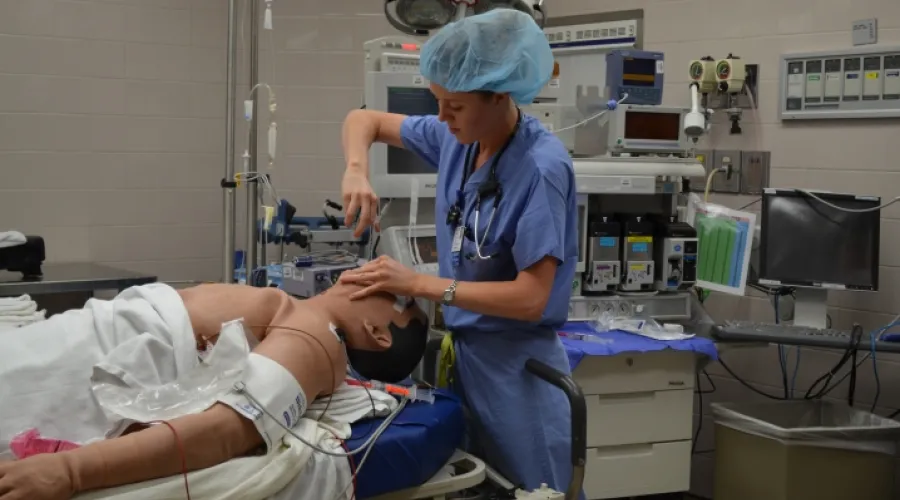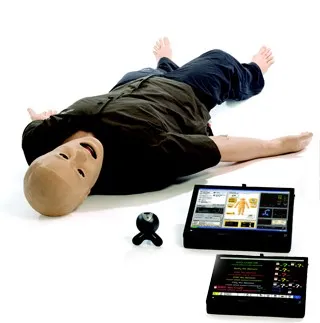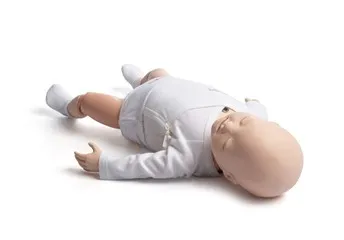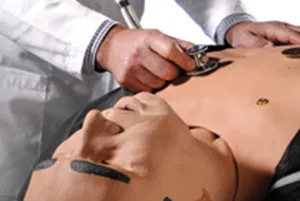
Patient Simulators
METI HPS
The HPS, designed by Medical Educational Technologies Incorporated , is a life-sized, fully automatic electromechanical mannequin upon which physiological and pharmacological models that determine cardiac and respiratory responses can be programmed to demonstrate many different acute cardiopulmonary clinical scenarios.
The HPS has a command computer and mechanical interface that simulates heart and breath sounds, palpable femoral and radial arterial pulses, and spontaneous and controlled ventilation. It also has the ability to monitor carbon dioxide exhalation, non-invasive hemodynamic monitoring, and arterial, central venous, and pulmonary artery pressure. The mannequin has a voice speaker mounted in the head and can be operated by the instructor from a remote location using a laptop computer. Drug recognition is via bar-coded, saline-filled syringes. The computer recognizes the volume, concentration, and type of drug given to the mannequin and produces an appropriate pharmacologic response.
The mannequin is designed to allow management of the airway both with mask ventilation and utilization of airway-assist devices such as the oral or nasopharyngeal airways, the laryngeal mask, combitube, endotracheal tube, and intubating laryngeal mask. The airway of the mannequin is designed to occlude in a graded and systematic fashion via use of compression of the larynx to simulate laryngospasm and the ability to inflate the tongue in a graded fashion to simulate a difficult airway and intubation. The mannequin also allows for both nasal and oral fiberoptic intubation with visualization to the carina and major lobes of the lungs. Retrograde intubation over a wire through the artificial cricothyroid membrane can also be performed.
To learn more about the features, visit here.

Laerdal SimMan 3G
The SimMan 3G patient simulator is controlled wirelessly. The drug recognition system allows students to administer drugs simultaneously. It registers the amount, speed, and type of drug automatically and applies the appropriate physiological responses. The simulator has several airway and breathing features and complications, cardiac features, eye signs, and secretions. In addition to airway management skills practice, the mannequin allows vascular access (standard vascular as well as intraosseous access via the tibia and sternum), needle thoracentesis, and insertion of a chest drain-bilaterally.
See the Laerdal SimMan 3G Patient Simulator features.

Laerdal SimBaby
The SimBaby patient simulator has realistic infant anatomy and clinical functionality. Students can practice multiple airway management skills including oropharyngeal and nasopharyngeal airways, bag-valve-mask ventilation, orotracheal and nasotracheal, intubation, Sellick maneuver, laryngeal mask airway insertion, endotracheal tube insertion, fiberoptic intubation, gastric tube insertion, and right main-stem intubation. The SimBaby features pulmonary and cardiovascular system functionality. Participants can practice unilateral chest tube insertion, venous access antecubital fossae, intraosseous insertion (bilateral), and IV bolus and infusion.

iStan
The iStan features breath, heart, bowel, and phonation sounds as well as an advanced cardiovascular and pulmonary system. The iStan's truama features include cricothyrotomy, articulated mandible, obstructed ear irrigation, oral and nasopharyngeal suctioning, neck articulation with cervical motion monitoring and ability to reduce range of motion, tri-state pupil size, teeth with breakaway incisors, laryngospasm, difficult (airway) occluder, tongue edema, trismus, jaw thrust, tension pneumothorax and hemothorax, needle decompression (bilateral), flail chest, chest tubes (bilateral), convulsions, sternal and tibial IO access, bilateral peripheral (dorsal vein and antecubital fossa) IV access, central (femoral and jugular) IV lines, and bilateral thigh auto-injection sites for medication administration.